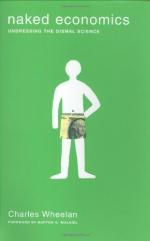
|
| Name: _________________________ | Period: ___________________ |
This test consists of 15 multiple choice questions and 5 short answer questions.
Multiple Choice Questions
1. In many countries, the negative effects of the Great Depression lasted until the start of what?
(a) World War II.
(b) Vietnam.
(c) World War I.
(d) The Korean War.
2. When did the California Gold Rush begin?
(a) 1912.
(b) 1862.
(c) 1969.
(d) 1849.
3. When was the first edition of "Naked Economics: Undressing the Dismal Science" published?
(a) 1995.
(b) 1997.
(c) 2002.
(d) 2006.
4. Charles Wheelan was an unsuccessful Democratic candidate in the special election for Illinois's 5th congressional district, the seat vacated by whom?
(a) Rahm Emanuel.
(b) Abraham Lincoln.
(c) Barack Obama.
(d) Bill Clinton.
5. According to the author in Chapter 12, studies show that globalizing countries had what percentage higher growth rate than other countries that were less integrated in the world economy?
(a) 15% to 25%.
(b) 30% to 50%.
(c) 50% to 75%.
(d) 10% to 20%.
6. What refers to economy-wide fluctuations in production or economic activity over several months or years?
(a) Trade-off.
(b) Depression.
(c) Recession.
(d) Business cycle.
7. When did the United Nations Monetary and Financial Conference take place?
(a) 1970.
(b) 1932.
(c) 1961.
(d) 1944.
8. What country had a bad reputation so it's government created a currency board ensuring that each of its pesos was worth one United States dollar?
(a) Ecuador.
(b) Argentina.
(c) Brazil.
(d) Peru.
9. What does GDP stand for?
(a) Gems and Diamonds Per capita.
(b) Gain and Drain Portfolio.
(c) Geographic Diversity Plot.
(d) Gross Domestic Product.
10. When did President Jefferson suspend the minting of silver coins in the U.S.?
(a) 1822.
(b) 1796.
(c) 1815.
(d) 1806.
11. Americans today are how many times as rich as an American in the 1940s according to the author in Chapter 9?
(a) 2.
(b) 14.
(c) 5.
(d) 10.
12. In finance, what between two currencies is the rate at which one currency will be exchanged for another?
(a) Deductible.
(b) Collateral.
(c) Devaluation.
(d) Exchange rate.
13. In economics, what refers to a general slowdown in economic activity?
(a) Depression.
(b) Trade-off.
(c) Recession.
(d) Business cycle.
14. Mark Miringhoff is a social science professor at what institution?
(a) Fordham University.
(b) The University of Alaska.
(c) The University of Chicago.
(d) Harvard University.
15. When was the Federal Reserve Act enacted?
(a) 1892.
(b) 1812.
(c) 1913.
(d) 1776.
Short Answer Questions
1. The delegates at the United Nations Monetary and Financial Conference created the World Bank, which is owned by how many member countries?
2. In order to get a true understanding of an economy, there are nine factors one should consider along with the GDP according to the author in Chapter 9. What is the second?
3. After World War II, representatives of the Allied nations gathered together where to create a sustainable financial infrastructure for the world?
4. According to the author in Chapter 13, some argue that high temperatures and heavy rainfall yield poor food production and and increase in what, therefore limiting a location's ability to create a thriving economy?
5. Nonperforming loans and bad investments caused the banks to suffer in Iceland, and by the fall of 2008, how many major banks in the country were defunct according to the author in Chapter 11?
|
This section contains 445 words (approx. 2 pages at 300 words per page) |

|




